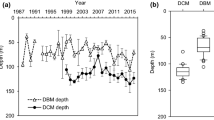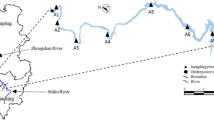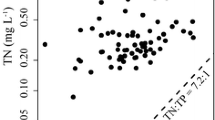Abstract
Anthropogenic nutrient enrichment of the coastal zone is now a well-established fact. However, there is still uncertainty about the mechanisms through which nutrient enrichment can disrupt biological communities and ecosystem processes in the coastal zone. For example, while some estuaries exhibit classic symptoms of acute eutrophication, including enhanced production of algal biomass, other nutrient-rich estuaries maintain low algal biomass and primary production. This implies that large differences exist among coastal ecosystems in the rates and patterns of nutrient assimilation and cycling. Part of this variability comes from differences among ecosystems in the other resource that can limit algal growth and production – the light energy required for photosynthesis. Complete understanding of the eutrophication process requires consideration of the interacting effects of light and nutrients, including the role of light availability as a regulator of the expression of eutrophication. A simple index of the relative strength of light and nutrient limitation of algal growth can be derived from models that describe growth rate as a function of these resources. This index can then be used as one diagnostic to classify the sensitivity of coastal ecosystems to the harmful effects of eutrophication. Here I illustrate the application of this diagnostic with light and nutrient measurements made in three California estuaries and two Dutch estuaries.
Similar content being viewed by others
References
Alpine AE and Cloern JE (1988) Phytoplankton growth rates in a light-limited environment, San Francisco Bay. Mar Ecol Prog Ser 44: 167–173
Alpine AE and Cloern JE (1992) Trophic interactions and direct physical effects control phytoplankton biomass and production in an estuary. Limnol Oceanogr 37: 946–955
Balls PW, Macdonald A, Pugh K and Edwards AC (1995) Long-term nutrient enrichment of an estuarine system: Ythan, Scotland (1958–1993). Environ Pollut 90: 311–321
Bauerfeind E, Hickel W, Niermann U and Westernhagen HV (1990) Phytoplankton biomass and potential nutrient limitation of phytoplankton development in the southeastern North Sea in spring 1985 and 1986. Neth J Sea Res 25: 131–142
Borum J (1996) Shallow waters and land/sea boundaries. In: Jørgensen BB and Richardson K (eds), Eutrophication in Coastal Marine Ecosystems (pp. 179–203) American Geophysical Union, Washington DC
Boynton WR, Kemp WM and Keefe CW (1982) A comparative analysis of nutrients and other factors influencing estuarine phytoplankton production. In: Kennedy VS (ed.), Estuarine Comparisons (pp. 69–90) Academic Press, New York
Cadée GC and Hegeman J (1986) Seasonal and annual variation in Phaeocystis pouchetii (Haptophyceae) in the westernmost inlet of the Wadden Sea during the 1973 to 1985 period. Neth J Sea Res 20: 29–36
Caffrey JM, Cole BE, Cloern JE, Rudek JR, Tyler AC and Jassby AD (1994) Studies of the San Francisco Bay, California, Estuarine Ecosystem. Pilot regional monitoring results, 1993. U.S. Geological Survey Open-File Report 94–82
Carignan R and Planas D (1994) Recognition of nutrient and light limitation in turbid mixed layers: three approaches compared in the Paraná floodplain (Argentina). Limnol Oceanogr 39: 580–596
Chapelle A, Lazure P and Ménesguen A (1994) Modelling eutrophication events in a coastal ecosystem. Sensitivity analysis. Est Coast Shelf Sci 39: 529–548
Cloern JE (1982) Does the benthos control phytoplankton biomass in South San Francisco Bay? Mar Ecol Prog Ser 9: 191–202
Cloern JE, Cole BE, Wong RLJ and Alpine AE (1985) Temporal dynamics of estuarine phytoplankton: a case study of San Francisco Bay. Hydrobiologia 129: 153–176
Cloern JE (1987) Turbidity as a control on phytoplankton biomass and productivity in estuaries. Cont Shelf Res 7: 1367–1382
Cloern JE, Grenz G and Vidergar-Lucas L (1995) An empirical model of the phytoplankton chlorophyll:carbon ratio — the conversion factor between productivity and growth rate. Limnol Oceanogr 40: 1313–1321
Cloern JE (1996) Phytoplankton bloom dynamics in coastal ecosystems: A review with some general lessons from sustained investigation of San Francisco Bay, California. Rev Geophysics 34: 127–168
Cole BE, Hager SW and Hollibaugh JT (1990) Hydrographic, biological, and nutrient properties of Tomales Bay, California, March 1985 to May 1986. U.S. Geological Survey Open-File Report 90–178
Colijn F (1984) Characteristics of primary production in the Dutch Wadden Sea. Neth Inst Sea Res Publ Ser 10: 41–50
DeGroodt EG and de Jonge VN (1990) Effects of changes in turbidity and phosphate influx on the ecosystem of the Ems estuary as obtained by a computer simulation model. Hydrobiologia 195: 39–47
de Jonge VN, Boynton W, D'Elia CF, Elmgren R and Welsh BL (1995) Responses to developments in eutrophication in four different North Atlantic estuarine systems. In: Dyer KR and Orth RJ (eds), Changes in Fluxes in Estuaries (pp. 179–196) Olsen and Olsen, Fredensborg, Denmark
Dillon PJ and Rigler FH (1975) A simple method for predicting the capacity of a lake for development based on lake trophic status. J Fish Res Board Can 32: 1519–1531
Escaravage V, Prins TC, Smaal AC and Peeters JCH (1996) The response of phytoplankton communities to phosphorus input reduction in mesocosm experiments. J Exp Mar Biol Ecol 198: 55–79
Fisher TR, Peele ER, Ammerman JW and Harding LW Jr. (1992) Nutrient limitation of phytoplankton in Chesapeake Bay. Mar Ecol Prog Ser 82: 51–63
Gowen RJ, Tett P and Jones KJ (1992) Predicting marine eutrophication: the yield of chlorophyll from nitrogen in Scottish coastal waters. Mar Ecol Prog Ser 85: 153–161
Granéli E (1987) Nutrient limitation of phytoplankton biomass in a brackish water bay highly influenced by river discharge. Estuar Coast Shelf Sci 25: 555–565
Hager SW (1994) Dissolved nutrient and suspended particulate matter data for the San Francisco Bay estuary, California, October 1991 through November 1993. U.S. Geological Survey Open-File Report 94–471
Hager SW and Schemel LE (1996) Dissolved inorganic nitrogen, phosphorus and silicon in South San Francisco Bay. I. Major factors affecting distributions. In Hollibaugh JT (ed.), San Francisco Bay, The Ecosystem (pp. 189–215) Pacific Division, American Association for the Advancement of Science, San Francisco
Harding LW Jr. (1994) Long-term trends in the distribution of phytoplankton in Chesapeake Bay: roles of light, nutrients and streamflow. Mar Ecol Prog Ser 104: 267–291
Herman PJ and Scholten H (1990) Can suspension-feeders stabilise estuarine ecosystems? In Barnes M and Gibson RN (eds) Trophic Relationships in the Marine Environment (pp. 104–116) Aberdeen University Press
Hildebrand FG (1974) Introduction to Numerical Analysis. McGraw Hill, New York
Kromkamp J and Peene J (1995) Possibility of net phytoplankton primary production in the turbid Schelde Estuary (SW Netherlands). Mar Ecol Prog Ser 121: 249–259
Le Pape O, Del Amo Y, Ménesguen A, Aminot A, Quequiner B and Treguer P (1996) Resistance of a coastal ecosystem to increasing eutrophic conditions: the Bay of Brest (France), a semi-enclosed zone of Western Europe. Cont Shelf Res 16: 1885–1907
Lohrenz SE, Dagg MJ and Whitledge TE (1990) Enhanced primary production at the plume/oceanic interface of the Mississippi River. Cont Shelf Res 10: 639–664
Madden CJ and Kemp WM (1996) Ecosystem model of an estuarine submersed plant community: calibration and simulation of eutrophication responses. Estuaries 19: 457–474
Millard ES, Myles DD, Johannsson OE and Ralph KM (1996) Seasonal phosphorus deficiency of Lake Ontario phytoplankton at two index stations: light versus phosphorus limitation of growth. Can J Fish Aquat Sci 53: 1112–1124
Monbet Y (1992) Control of phytoplankton biomass in estuaries: A comparative analysis of microtidal and macrotidal estuaries. Estuaries 15: 563–571
Nixon SW (1992) Quantifying the relationship between nitrogen input and the productivity of marine ecosystems. In: Takahashi M, Nakata K and Parsons TR (eds), Proceedings of Advanced Marine Technology Conference, Vol. 5 (pp. 57–83) Tokyo, Japan
Nixon SW (1995) Coastal marine eutrophication: a definition, social causes, and future concerns. Ophelia 41: 199–219
Oviatt C, Doering P, Nowicki B, Reed L, Cole J and Frithsen J (1995) An ecosystem level experiment on nutrient limitation in temperate coastal marine environments. Mar Ecol Prog Ser 116: 171–179
Paasche E and Erga SR (1988) Phosphorus and nitrogen limitation of phytoplankton in the inner Oslofjord (Norway). Sarsia 73: 229–243
Pennock JR and Sharp JH (1994) Temporal alternation between light-and nutrient-limitation of phytoplankton production in a coastal plain estuary. Mar Ecol Prog Ser 111: 275–288
Pennock JR, Sharp JH and Schroeder WS (1994) What controls the expression of estuarine eutrophication? Case studies of nutrient enrichment in the Delaware Bay and Mobile Bay estuaries, USA. In: Dyer KR and Orth RJ (eds), Changes in Fluxes in Estuaries (pp. 139–146) Olsen and Olsen, Fredensborg, Denmark
Peterson DH, Schemel LE, Smith RE, Harmon DD and Hager SW (1987) The flux of particulate organic carbon in estuaries: Phytoplankton productivity and oxygen consumption. U.S. Geological Survey Water Supply Series, Selected Papers in the Hydrologic Sciences, p. 41–49
Platt T, Sathyendranath S and Ravindran P (1990) Primary production by phytoplankton: analytic solutions for daily rates per unit of water surface. Proc R Soc London Ser B 241: 101–111
Platt T, Bird DF and Sathyendranath S (1991) Critical depth and marine primary production. Proc R Soc London Ser B 246: 205–217
Prins TC, Escaravage V, Smaal AC and Peeters JCH (1995) Nutrient cycling and phytoplankton dynamics in relation to mussel grazing in a mesocosm experiment. Ophelia 41: 289–315
Rabalais NN, Turner RE, Justić D, Dortch Q, Wiseman WJ Jr. and Sen Gupta BK (1996) Nutrient changes in the Mississippi River and system responses on the adjacent continental shelf. Estuaries 19: 386–407
Radach G, Berg J and Hagmeier E (1990) Long-term changes of the annual cycles of meteorological, hydrographic, nutrient and phytoplankton time series at Helgoland and at LV ELBE 1 in the German Bight. Cont Shelf Res 10: 305–328
Richardson K and Heilmann JP (1995) Primary production in the Kattegat: Past and present. Ophelia 41: 317–328
Riemann B, Nielsen TG, Horsted SJ, Bjørnsen PK and Pock-Steen J (1988) Regulation of phytoplankton biomass in estuarine enclosures. Mar Ecol Prog Ser 48: 205–215
Rosenberg R and Loo L-O (1988) Marine eutrophication induced oxygen deficiency: effects on soft bottom fauna, western Sweden. Ophelia 29: 213–225
Smetacek V, Bathmann U, Nöthig E-M and Scharek R (1991) Coastal eutrophication: causes and consequences. In: Mantoura RFC, Martin J-M and Wollast R (eds), Ocean Margin Processes in Global Change (pp. 251–279) John Wiley & Sons
Visser AW and Kamp-Nielsen L (1996) The use of models in eutrophication studies. In: Jørgensen BB and Richardson K (eds.) Eutrophication in Coastal Marine Ecosystems (pp. 221–242) American Geophysical Union, Washington D.C.
Vollenweider RA and Kerekes J (1980) The loading concept as basis for controlling eutrophication: philosophy and preliminary results of the OECD programme on eutrophication. Prog Water Technol 12: 5–38
Wetsteyn LPMJ and Kromkamp JC (1994) Turbidity, nutrients and phytoplankton primary production in the Oosterschelde (The Netherlands) before, during and after a large-scale coastal engineering project (1980–1990). Hydrobiologia 282/283: 61–78
Wienke SM, Cole BE and Cloern JE (1993) Plankton studies in San Francisco Bay, California. XIV. Chlorophyll distributions and hydrographic properties of San Francisco Bay, 1992. U.S. Geological Survey Open-File Report 93–423
Wofsy S (1983) A simple model to predict extinction coefficients and phytoplankton biomass in eutrophic waters. Limnol Oceanogr 28: 1144–1155
Author information
Authors and Affiliations
Rights and permissions
About this article
Cite this article
Cloern, J.E. The relative importance of light and nutrient limitation of phytoplankton growth: a simple index of coastal ecosystem sensitivity to nutrient enrichment. Aquatic Ecology 33, 3–15 (1999). https://doi.org/10.1023/A:1009952125558
Issue Date:
DOI: https://doi.org/10.1023/A:1009952125558




